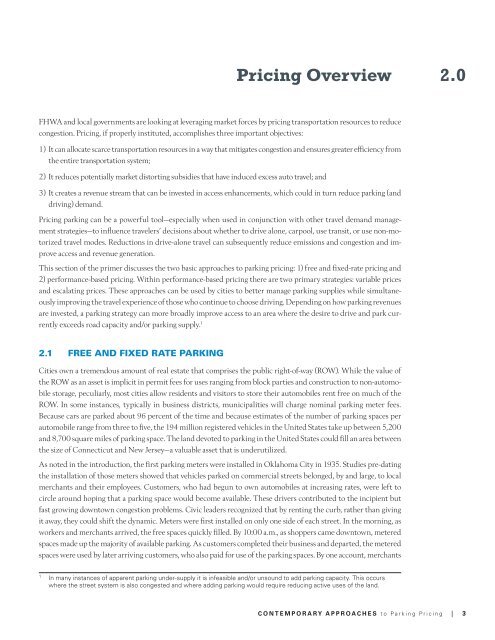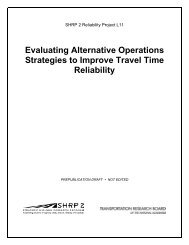Contemporary Approaches to Parking Pricing: - FHWA Operations
Contemporary Approaches to Parking Pricing: - FHWA Operations
Contemporary Approaches to Parking Pricing: - FHWA Operations
You also want an ePaper? Increase the reach of your titles
YUMPU automatically turns print PDFs into web optimized ePapers that Google loves.
<strong>Pricing</strong> Overview<br />
2.0<br />
<strong>FHWA</strong> and local governments are looking at leveraging market forces by pricing transportation resources <strong>to</strong> reduce<br />
congestion. <strong>Pricing</strong>, if properly instituted, accomplishes three important objectives:<br />
1) It can allocate scarce transportation resources in a way that mitigates congestion and ensures greater efficiency from<br />
the entire transportation system;<br />
2) It reduces potentially market dis<strong>to</strong>rting subsidies that have induced excess au<strong>to</strong> travel; and<br />
3) It creates a revenue stream that can be invested in access enhancements, which could in turn reduce parking (and<br />
driving) demand.<br />
<strong>Pricing</strong> parking can be a powerful <strong>to</strong>ol—especially when used in conjunction with other travel demand management<br />
strategies—<strong>to</strong> influence travelers’ decisions about whether <strong>to</strong> drive alone, carpool, use transit, or use non-mo<strong>to</strong>rized<br />
travel modes. Reductions in drive-alone travel can subsequently reduce emissions and congestion and improve<br />
access and revenue generation.<br />
This section of the primer discusses the two basic approaches <strong>to</strong> parking pricing: 1) free and fixed-rate pricing and<br />
2) performance-based pricing. Within performance-based pricing there are two primary strategies: variable prices<br />
and escalating prices. These approaches can be used by cities <strong>to</strong> better manage parking supplies while simultaneously<br />
improving the travel experience of those who continue <strong>to</strong> choose driving. Depending on how parking revenues<br />
are invested, a parking strategy can more broadly improve access <strong>to</strong> an area where the desire <strong>to</strong> drive and park currently<br />
exceeds road capacity and/or parking supply. 1<br />
2.1 Free and Fixed Rate <strong>Parking</strong><br />
Cities own a tremendous amount of real estate that comprises the public right-of-way (ROW). While the value of<br />
the ROW as an asset is implicit in permit fees for uses ranging from block parties and construction <strong>to</strong> non-au<strong>to</strong>mobile<br />
s<strong>to</strong>rage, peculiarly, most cities allow residents and visi<strong>to</strong>rs <strong>to</strong> s<strong>to</strong>re their au<strong>to</strong>mobiles rent free on much of the<br />
ROW. In some instances, typically in business districts, municipalities will charge nominal parking meter fees.<br />
Because cars are parked about 96 percent of the time and because estimates of the number of parking spaces per<br />
au<strong>to</strong>mobile range from three <strong>to</strong> five, the 194 million registered vehicles in the United States take up between 5,200<br />
and 8,700 square miles of parking space. The land devoted <strong>to</strong> parking in the United States could fill an area between<br />
the size of Connecticut and New Jersey—a valuable asset that is underutilized.<br />
As noted in the introduction, the first parking meters were installed in Oklahoma City in 1935. Studies pre-dating<br />
the installation of those meters showed that vehicles parked on commercial streets belonged, by and large, <strong>to</strong> local<br />
merchants and their employees. Cus<strong>to</strong>mers, who had begun <strong>to</strong> own au<strong>to</strong>mobiles at increasing rates, were left <strong>to</strong><br />
circle around hoping that a parking space would become available. These drivers contributed <strong>to</strong> the incipient but<br />
fast growing down<strong>to</strong>wn congestion problems. Civic leaders recognized that by renting the curb, rather than giving<br />
it away, they could shift the dynamic. Meters were first installed on only one side of each street. In the morning, as<br />
workers and merchants arrived, the free spaces quickly filled. By 10:00 a.m., as shoppers came down<strong>to</strong>wn, metered<br />
spaces made up the majority of available parking. As cus<strong>to</strong>mers completed their business and departed, the metered<br />
spaces were used by later arriving cus<strong>to</strong>mers, who also paid for use of the parking spaces. By one account, merchants<br />
1<br />
In many instances of apparent parking under-supply it is infeasible and/or unsound <strong>to</strong> add parking capacity. This occurs<br />
where the street system is also congested and where adding parking would require reducing active uses of the land.<br />
C o n t e m p o r a r y A p p r o a c h e s t o P a r k i n g P r i c i n g | 3















